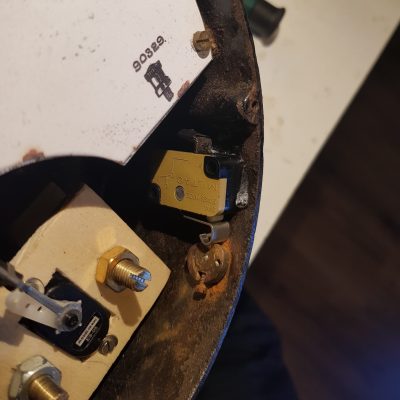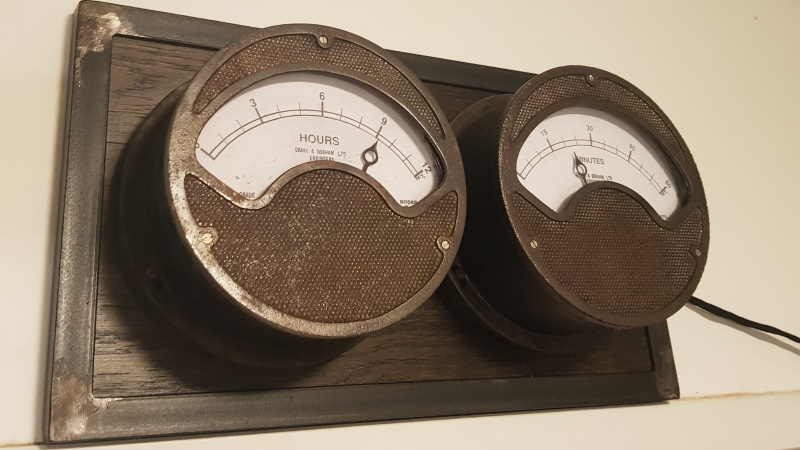[Build Comics], purveyors of comic strips “where tools are heroes”, have saved another pair of old, vintage, analog meters from the junkyard by converting them into a Meter Clock. The real heroes of the story are their trusty tools – Mac X the knife, Mr. TS the table saw and his trusty band of clamps, G. Rinder the angle grinder, Weldy the welder, Sharp Eye the marker, rounded up by Sandy the Sander and Jiggy Saw. The Drake & Gorham (London) meters going under the knife appear similar to vintage hardware from just after the end of World War II, such as this Ferranti Ammeter found at the Science Museum Group, making them at least 75 years old.

As you might expect, the conversion process is reminiscent of their previous projects. The original moving-coil movements are discarded, and the pointer is attached to a servo which will act as the new movement. Fresh dials are prepared to replace the original ampere markings with hours and minutes. To retain some of the original charm, the new dials have discoloration and blemishes replicated from the old dials.
The set screw which was once used to align the pointer with the zero mark on the dial is now used to activate a micro switch that enables daylight savings time. Two additional buttons provide a convenient interface to adjust the time. Precision time signals are derived from a DS3231 RTC module connected to an Arduino. A pair of seven segment displays are connected to the Arduino to make it easier to set the time. A piece of oak plank, surrounded by a metal angled frame, is used as a base for mounting the two meters so that the clock can be hung up on the wall.
If you’d like to build some more vintage inspired instrumentation, [Build Comics] have you covered with a Classy Weather Display or a Plant Moisture Gauge.
















“The original moving-coil movements are discarded, and the pointer is attached to a servo which will act as the new movement. Fresh dials are prepared to replace the original ampere markings with hours and minutes.”
I’m sorry, this is not cool. You just want the case? Vintage analog movements, discarded? Some of those things are made like swiss watches. Why not just go 3D print a looky-likey case, and stuff your servos and labels into that? Do you really need to gut an antique? Please tell me these were under water and corroded to hell before you went to town..
My god. I am in the middle of designing a box with 6 cheap 100uA panel meters from China as 0-100% gauges for monitoring system loads (I might have to stick this on Hackaday.io now that I think of it) and I am still using the original coil moving system based on PWM output. Driving panel meters is every bit as easy as a servo, and is far more precise.
I would not use a cheap hobby servo for anything requiring precision movement, if I needed something small and simple I would use a stepper motor.
Hey guys, just a note, normally I definitely keep the moving coils intact. But these had seen some serious water over their life time and were rusted shut, no way of salvaging the movement, so this was the next best thing :-).
A “before” picture would have been a good idea. Maybe still a good idea, if you have one
Just Glue Some Gears On It (And Call It Steampunk)…
I am getting fed up with that….glue some gears on and call it Steampunk. I have seen pieces of pipe with an LED Edison bulb making it a “Vintage Looking Steampunk” lamp listed for $100. Ridiculous perversion of what real Steampunk is.
I could not agree more.
And as a vintage watch restorer, my eyes bleed at people hotgluing waltham watch gears to plastic goggles.
I hate steampunk. I hate the word even at this point. The aesthetic has been beaten to death by too many people with hot glue guns and a tophat. It just makes me angry at this point.
It’s become a butchery and cheesening of everything mechanically beautiful to me by people who can’t craft in metal for real, so they stick mechanical parts together with glue and plastic like magpies with no taste.
This is probably much the same feeling I get when I see blue LEDs placed under various bits of vacuum-state electronics.
But…that’s the trendy fashion nowadays!
(Nice reference.)
They should have used pressure gauges (from when stream was king), and fed them from compressed air controlled by the clock output.
PWM from an auxetophone valve. ;-)
Omg, could it be possible to create logic gates that work directly on live steam? All we need is NOT and AND, from there the flip-flop, then whip up some mod 6, 10 and 12 counters .. a literal steam clock? Going to have to think about this
For some reason, when I was in school, the current fad was showing pneumatics as an analogy for the working of electronics. Not sure it helped the ppl who had no mechanical aptitude either, since you couldn’t actually see the valves working, it was just a different black box. Anyway, yes there were just enough parts for the simple gates on the demo board, which was a kind of fat hole pegboard the actuators, valves and unions plugged into, about 2″ x 3″ so you’d have covered a classroom in them trying to build an adder or something.
Pre mid-90s and a handful after, automatic transmissions were hydraulically controlled by a valvebody. Which looks like it should have a Minotaur living in it or something, but was actually a hybrid digital/analog computer which worked out and controlled how fast to move the clutch packs in and out and shift things along shafts etc to make the gearbox shift under particular RPM and load conditions. Control was by various spring biased valves, and ball bearings, driven by pump pressure.
What a waste of vintage meters. All they had to do was use a coil driver. Using servos is just… it’s shameful.
Sacrilege! …and you employed Chinese parts. For shame.
It’s pretty easy to drive an old analog meter from an Arduino quite precisely using PWM. Here is my code:
/*
PWM Meter control
*/
#define FULLSCALEVALUE 240
#define ZEROVALUE 25
int meterPin = 9; // Meter connected to digital pin 9
void setup()
{
}
void loop()
{
for(byte i=0; i<=100; i++){
meterZero();
delay(10);
}
delay(1000);
for(byte i=0; i<=100; i++){
meterFull();
delay(10);
}
meterSweep();
delay(1000);
}
void meterSet(int val) //Set meter to value from 1..1000
{
analogWrite(meterPin, (byte(val/(1000/FULLSCALEVALUE))));
}
void meterZero() //Set meter to zero point
{
analogWrite(meterPin, ZEROVALUE);
}
void meterFull() //Set meter to ful scale value
{
analogWrite(meterPin, FULLSCALEVALUE);
}
void meterSweep()
{
meterZero();
delay(750);
for(int fadeValue = ZEROVALUE ; fadeValue = ZEROVALUE; fadeValue -=1) {
analogWrite(meterPin, fadeValue);
delay(20);
}
}
or use an esp32 since it has two DACs and do time sync with NTP
Yes maintaing the moving coil meter would also have been silent – if they have used cheap servos I would suspect a fair bit of noise to be created – possibly more annoying than a ticking a clock.
On the other hand if the meter coils were toast than it would be sensible to rip the guts out and rebuild with something new
> if the meter coils were toast than it would be sensible
As my math teachers used to like to say, “if and only if”
Saabman did guess correct, allthough not clear, the mechanism was rusted shut.
Apparently my first comment didn’t have enough substance to get through the moderators…
I don’t reply much but I feel my disdain for destroying vintage meters with a servo warrants another attempt..
This is definitely a “hack” alright… but only in the most negative of context.
They said the meters have ‘seen better days’, but they didn’t look too beat up to me.
If they weren’t already dead, that’s just needless destruction of two beautiful meters for a non-remarkable implementation of a played out trope.
Kinda bummed to see they gutted the original coil movement to replace with servos, but I guess whatever works for the op, it’s their project. I built a meter clock a few years ago using cheap chinese ammeters. I ended up using two serial DACs to drive them that I just got as a learning exercise (I know I could’ve just used PWM but the DACs were shiny and begging me to use them, it was a good experience).
What could the original application have been, that required measuring 160A? Something in a power station?
Could just have been for starter draw on an industrial engine of modest power, or on tractor, bulldozer or other equipment. Or could have been electrically powered equipment such as a tram, excavator or locomotive. Come to think of it, light trucks have been known to have 200A alternators, so might be for charge also. That’s at the relatively “low power” DC end. Things like printing presses and other industrial machinery need quite a lot of amps to start moving at higher AC voltages.
Power stations, but also large factories had tons of these things. I have meters that go higher than that even. Factories mostly had their own “power station” to monitor everything. Actually, most still do but analog meters are not the standard anymore somehow.
I came across one marked 2000 Amps, but it must have been externally shunted or indirectly measured because it slammed across quick enough with a 1.5V AA applied. At a guess I’d have said 200mA movement. Didn’t pick it up from that fleamarket though, since it was in an “everything a buck” scratch through box and stallholder saw it flick over and said “Oh it works, $10” and he wasn’t joking. So I dropped everything and went somewhere else.
External shunts are the norm for higher current ammeters, as they get rather chonky.
True, I’m thinking a shunt for a couple of thousand Amps was probably practically an ingot.